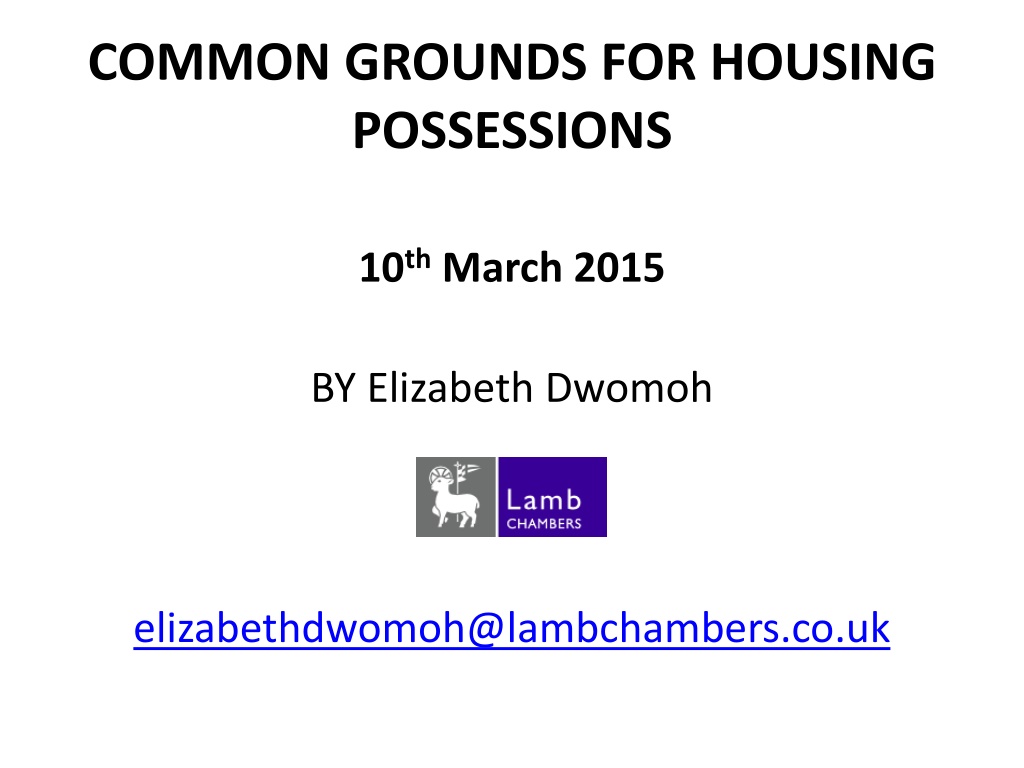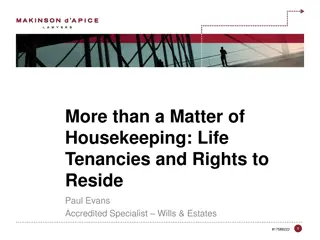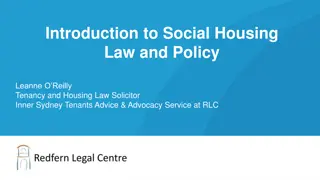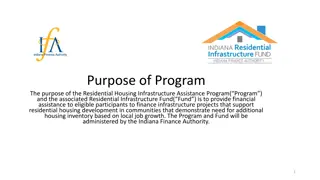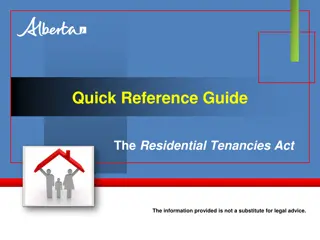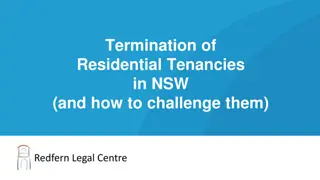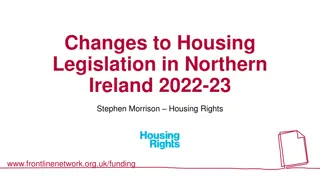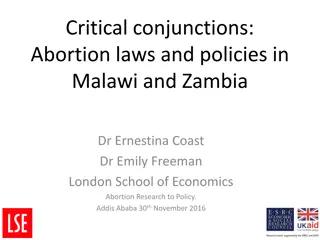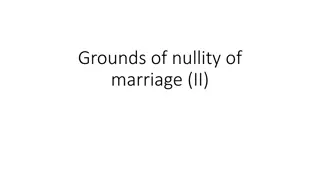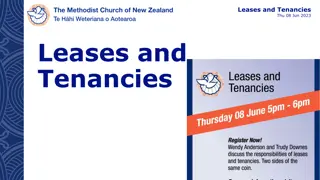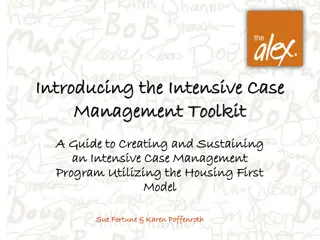Understanding Residential Tenancies: Common Grounds for Housing Possessions
This content discusses common grounds for housing possessions in residential tenancies, focusing on types of tenancies, security of tenure, and defenses for tenants facing possession claims by landlords. It covers secure tenancies, assured tenancies, and assured shorthold tenancies, highlighting the conditions and features of each. The seminar also delves into the nature of a tenant's right to occupy a property and the procedural steps involved in terminating a tenancy.
Download Presentation

Please find below an Image/Link to download the presentation.
The content on the website is provided AS IS for your information and personal use only. It may not be sold, licensed, or shared on other websites without obtaining consent from the author. Download presentation by click this link. If you encounter any issues during the download, it is possible that the publisher has removed the file from their server.
E N D
Presentation Transcript
COMMON GROUNDS FOR HOUSING POSSESSIONS 10thMarch 2015 BY Elizabeth Dwomoh Chambers logo - lamb with flag and words Lamb Chambers - links to homepage elizabethdwomoh@lambchambers.co.uk
Focus of the seminar This seminar focuses on the following: the most commonly encountered residential tenancies; the common grounds for possession used by social and private landlords in the residential sector; and the potential substantive and technical defences that can be deployed to assit tenants resist their landlords claim for possession.
What type of tenancy does the tenant hold? Identifying the nature of a tenant s right to occupy the property is essential: it determines the type of security of tenure a tenant possesses; and it will dictate the substantive grounds under which a landlord can terminate a tenancy and the procedural steps he or she must take to do so.
What are the most common type of residential tenancies? Secure tenancies; Assured tenancies; and Assured shorthold tenancies (AST).
Features of an secure tenancy The property to be let is a dwelling-house. The landlord condition must be satisfied The tenant must be an individual person and not a company. The tenant condition must be met. the property was let as a separate dwelling. The tenancy is not in an excluded category.
What are the common features of an assured tenancy and assured shorthold tenancy? An AST is a type of an assured tenancy. In order for both types of tenancies to arise the following conditions must be met: The tenancy must be of a dwelling-house let as a separate dwelling; The tenant must be an individual person, or if joint tenants they must all be individuals persons. The tenant condition must be satisfied. The tenancy must not be one that is excluded by virtue of HA 1988, Schedule 1. There must be a tenancy and the tenant must have exclusive possession of at least part of the property.
Assured tenancy: security of tenure Landlord can only terminate an assured tenancy by bringing possession proceedings and obtaining a possession order. An order for possession will only be made if at least one or more of the statutory grounds for possession are proven by the landlord. If a fixed term assured tenancy agreement contains a break clause, the landlord can bring the fixed term tenancy to an end by exercising the break clause, but....
HA 1988, 5(2) If an assured tenancy which is a fixed term tenancy comes to an end otherwise than by virtue of (a) an order of the court... or (b) a surrender or other action on the part of the tenant then... the tenant shall be entitled to remain in possession of the dwelling-house let under that tenancy and... his right to possession shall depend upon a periodic tenancy arising by virtue of this section.
Assured shorthold tenancies and security of tenure An AST is usually granted for a period of six months or longer. After the expiry of the fixed term period the tenant loses his or her substantive security of tenure. To recover possession a landlord is only required to serve notice and obtain a possession order.
HA 1985, 84(2) (2)The court shall not make an order for possession (a) on the grounds set out in Part I of Schedule 2 (grounds 1 to 8), unless it considers it reasonable to make the order, on the grounds set out in Part II of that Schedule (grounds 9 to 11), unless it is satisfied that suitable accommodation will be available for the tenant when the order takes effect, on the grounds set out in Part III of that Schedule (grounds 12 to 16), unless it both considers it reasonable to make the order and is satisfied that suitable accommodation will be available for the tenant when the order takes effect; and Part IV of that Schedule has effect for determining whether suitable accommodation will be available for a tenant. (b) (c)
HA 1985, Schedule 2 The grounds for seeking possession in relation to a secure tenancy are as follows: Part I: Ground 1 rent arrears or breach of the tenancy agreement Ground 2 nuisance/annoyance; criminal activity Ground 2ZA conviction for an indictable offence committed during the course of a riot Ground 2A domestic violence Ground 3 condition of dwelling-house has deteriorated by acts of waste etc. Ground 4 condition of furniture has deteriorated Ground 5 tenancy obtained by false statement Ground 6 tenancy assigned and premium paid Ground 7 dwelling-house consists of a housing other than housing accommodation Ground 8 temporary accommodation provided whilst works being undertaken
HA 1985, Schedule 2 continued Part II: Ground 9 overcrowding Ground 10 landlord is carrying out works Ground 11 landlord is a charity and the tenant s continued occupation conflicts with the landlord s aims Part III: Ground 12 accommodation is required for landlord s employees Ground 13 accommodation required for the physically disabled Ground 14 accommodation required by housing association or housing trusts for special needs Ground 15 accommodation required for special needs Ground 16 under occupation
The Notice of Seeking Possession (NOSP) a NOSP served by a landlord should inform the tenant of the following: the factual matters upon which the landlord will rely on; the legal ground(s) relied upon by the landlord to recover possession; and the date after which possession proceedings will be brought.
Technical defence: defective NOSP A NOSP is defective if it does not comply with the following rules set out in HA 1985, s.83(2): (2) A notice under this section shall (a) be in a form prescribed by regulations made by the Secretary of State, (b) specify the ground on which the court will be asked to make the order, and (c) give particulars of that ground.
Defective NOSP continued Further the NOSP is defective if: it fails to state that possession proceedings will commence immediately if ground 2 (nuisance), is relied upon and the date which the landlord requires possession. In relation to the remaining grounds, the specified date for possession should be the date after which possession proceeding may be commenced; the NOSP is not served on a periodic secure tenant within 12 months from the specified date.
Ground 1: Rent lawfully due from the tenant has not been paid... What is meant by rent? What is meant by rent lawfully due? Is rent due from the tenant?
Rent arrears: reasonableness The Court is entitled to take any factor it considers relevant into consideration when making its decision. The following are relevant factors: the duration of the tenancy; the level of the arrears would a money judgment suffice? history of rental payments; whether previous agreements to pay rent arrears have been broken by the tenant; reasons for the arrears (e.g. Housing Benefit ( HB ) issues/bedroom tax); whether the landlord has followed the Protocol for Possession Claims based on Rent Arrears ( the Rent Arrears Protocol ).
Protocol for Possession Claims based on Rent Arrears ( the Rent Arrears Protocol ) Under the Rent Arrears Protocol a landlord should: have early contact with the tenant to discuss: causes of arrears, tenant s financial circumstances, tenant s entitlements to benefits; agree with the tenant if possible the tenant should try and agree affordable sums for the tenant to pay towards the arrears; provide quarterly rent statements to the tenant in a comprehensible format; consider whether the tenant has difficulty understanding information/is vulnerable; agree, if possible, for arrears to be paid by direct deductions from the tenant s benefits; assist the tenant with issues relating to non-payment of HB; not start the claim if the tenant (a) provided the landlord with all info to process HB claim and (b) reasonable expectation of eligibility for HB; advise the tenant to receive advice from CAB, debt advice agencies etc; after serving statutory notices, should make efforts to contact the tenant to discuss any problems; should explore the possibility of an agreement being reached with the tenant to pay off the arrears; should explore whether ADR may be a realistic possibility in addressing any issues that arise; at least 10 days before hearing, should provide the tenant with an up-to-date rent statements and disclose his or her knowledge of the HB position; Inform the tenant of the court hearing and postpone the hearing date if necessary.
Counterclaim? Potential to set-off any rent arrears against an award of damages for a landlord s breach of covenant e.g. obligation to keep the property in repair.
Checklist for ground 1: rent arrears claim for possession Is the NOSP defective? What is the level of the rent arrears? Are these agreed? Has the landlord followed the Rent Arrears Protocol? Are there any unresolved Housing Benefit issues? Can a reasonable payment agreement be reached between the parties? Is there a potential for a set-off, e.g. a counterclaim for disrepair?
Ground 2: nuisance/annoyance and criminality
Ground 2 The tenant or a person residing in or visiting the dwelling-house (a) has been guilty of conduct causing or likely to cause a nuisance or annoyance to a person residing, visiting or otherwise engaging in a lawful activity in the locality, (aa) has been guilty of conduct causing or likely to cause a nuisance or annoyance to the landlord of the dwelling-house, or a person employed (whether or not by the landlord) in connection with the exercise of the landlord's housing management functions, and that is directly or indirectly related to or affects those functions, or (b) has been convicted of (i) using the dwelling-house or allowing it to be used for immoral or illegal purposes, or (ii) an indictable offence committed in, or in the locality of, the dwelling-house.
Nuisance/annoyance and criminality: reasonableness HA 1985, s.85A(2): The court must consider, in particular (a) the effect that the nuisance or annoyance has had on persons other than the person against whom the order is sought; (b) any continuing effect the nuisance or annoyance is likely to have on such persons; (c) the effect that the nuisance or annoyance would be likely to have on such persons if the conduct is repeated.
Nuisance/annoyance and criminality: reasonableness continued Other relevant discretionary factors: the type of nuisance; the frequency and duration of the nuisance; any warnings issued by the landlord that have gone unheeded; whether the tenant has shown remorse and is attempting to improve his or her behaviour (Manchester CC v Higgins [2005] EWCA Civ 1423, [2006] HLR 14); criminal convictions relating to the behaviour; if the anti-social behaviour is caused by a tenant s visitors can they be prevented from visiting the property?; compliance with the terms of an ASBI by the tenant.
Checklist for Ground 2: nuisance /annoyance and criminality Is the NOSP defective? Has the tenant requested a copy of the landlord s anti-social behaviour policy and if so has it been followed? Has the tenant s behaviour improved? Is there any prospect of the tenant s behaviour improving in the immediate future e.g. through therapy ? If a tenant s visitors are causing the anti-social behaviour, can they be prevented from visiting the Property?
Grounds for possession: overview Pursuant to HA 1988, s.7 a Court must be satisfied that one or more of the grounds set out in HA 1988, Schedule 2 is made out before an order for possession can be made. Grounds 1 to 8 are mandatory grounds for possession. If proved the Court must make a possession order. Grounds 9 to 17 are discretionary grounds for possession. If proved the Court the court may exercise its discretion not to grant possession if it would not be reasonable to do so.
The grounds: mandatory Ground 1 Owner occupiers Ground 2 Mortgagees Ground 3 Holiday lets Ground 4 Educational institutions Ground 5 Ministers of religion Ground 6 Demolition or reconstruction Ground 7 Death of the tenant Ground 8 Eight weeks or 2 months worth or rent arrears
The grounds: discretionary Ground 9 Suitable alternative accommodation Ground 10 Rent arrears Ground 11 Persistent delays in paying rent Ground 12 Breach of any obligation Ground 13 Waste or neglect Ground 14 Nuisance/annoyance or criminal conviction Ground 14A Violence to occupier Ground 15 Deterioration of furniture Ground 16 Premises let to employees Ground 17 tenancy induced by false statement
HA 1988, s.8: Notice Seeking Possession ( NSP ) & technical defences Before a landlord can commence possession proceedings against an assured tenant, he must serve a s.8, Notice Seeking Possession ( NSP ) on the tenant. The notice served must: state the full ground(s) for possession; state the particulars relied upon for the ground(s) of possession; be in the prescribed form or substantially to the same effect; state the specified date after which proceedings may commence.
NSP: service the NSP must be served on the tenant ; if the tenancy agreement expressly incorporates the Law of Property Act 1925, s.196, service can be effected by delivery to the property; Failure by a landlord to properly serve a valid NSP is fatal in relation to ground 8 as the Court has no discretion to dispense with service of a notice before proceedings are begun. Save for ground 8, the Court has discretion to dispense with service of the NSP before possession proceedings are commenced by the landlord if it considers it just and equitable to do so ; A NSP expires twelve months after the date that it is served.
Ground 14: nuisance/annoyance and criminality
Ground 14: Nuisance/annoyance and criminality Drafted in the exact same terms of HA 1985, Part I, Schedule 2; The landlord must also establish that it is reasonable for a possession order to be made; The Court is again required to consider the same relevant factors in assessing reasonableness as it does in respect of secure tenants. The Court must therefore consider the effect that the nuisance complained of is having on others when considering whether it is reasonable to make an order for possession (HA 1988, s, 9A); Has the landlord drafted and followed its Anti-social behaviour policy?
Mandatory ground 8 Both at the date of the service of the notice under section 8 of this Act relating to the proceedings for possession and at the date of the hearing (a) if rent is payable weekly or fortnightly, at least eight weeks' rent is unpaid; if rent is payable monthly, at least two months' rent is unpaid; if rent is payable quarterly, at least one quarter's rent is more than three months in arrears; and if rent is payable yearly, at least three months' rent is more than three months in arrears; and for the purpose of this ground rent means rent lawfully due from the tenant. (b) (c) (d) A landlord must prove that at the date the NSP was served and at the date of the hearing the tenant was either eight weeks or two months in arrears.
Mandatory ground 8: Adjournment The Court of Appeal in the case of North British Housing Association Limited v Matthews [2004] EWCA Civ 1736, held that the power of the Court to adjourn could only be exercised in exceptional circumstances. The fact that the arrears were attributable to maladministration in the payment of HB by the relevant body was not an exceptional reason to grant an adjournment. If the tenant were to raise a procedural argument or a substantive defence that required more time to be properly dealt with by the Court a short adjournment may be granted.
Counterclaim? Potential to set-off any rent arrears against an award of damages for a landlord s breach of covenant e.g. obligation to keep the property in repair.
Checklist for mandatory ground 8 Is the level of the rent arrears agreed? Is the NSP valid? Has the NSP been properly served? Has the claim been commenced within 12 months of the date of service of the NSP? Has the claim been commenced before the expiry of the specified date? Is there any prospect of reducing the level of arrears below the mandatory threshold? For example, a counterclaim for disrepair or a discretionary payment towards the arrears; Is there any potential exceptional hardship caused to the tenant if possession was granted within 14 or 28 days?
Discretionary Grounds 10 and 11 Ground 10: some rent lawfully due from the tenant (a) is unpaid on the date on which the proceedings for possession are begun; (b) except where section (1)(b) of section 8 of this Act applies, was in arrears at the date of the service of the notice under that section relating to those proceedings. Ground 11: Whether or not any rent is in arrears on the date on which proceedings for possession are begun, the tenant has persistently delayed paying rent which has become lawfully due.
Grounds 10 and 11: reasonableness The Court is entitled to take any factor it considers relevant into consideration when making its decision. The following are relevant factors: the duration of the tenancy; the level of the arrears would a money judgment suffice? history of rental payments; whether previous agreements to pay rent arrears have been broken by the tenant; reasons for the arrears (e.g. Housing Benefit ( HB ) issues/bedroom tax); whether the landlord has followed the Protocol for Possession Claims based on Rent Arrears ( the Rent Arrears Protocol ).
Checklist for discretionary grounds 10 and 11 Is the NSP defective? What is the level of the rent arrears? Are these agreed? Has the landlord followed the Rent Arrears Protocol? Are there any unresolved Housing Benefit issues? Can a reasonable payment agreement be reached between the parties? Is there a potential for a set-off, e.g. a counterclaim for disrepair?
Public law and human rights defences Public law and human rights defences can be raised in the County Court when a tenant is faced with a claim for possession by a local authority or registered provider exercising a public function. Human rights challenges arise: Usually on the basis of article 8 ECHR (respect for home and private and family life). A tenant is ultimately seeking to argue that an eviction would be disproportionate to the aim pursued by the landlord. As the County Court can in principle, review the proportionality of an eviction. However, it will only be in exceptional circumstances that defences based on proportionality will be arguable.
Public law and human rights defences continued A public law challenge can arise: because the landlord has failed to act in accordance with the law. For example the case where a local authority landlord has failed to consider the issue of a tenant s disability under the Equality Act 2010 if it is a factor in a claim brought against the tenant on the grounds of anti-social behaviour; where the landlord has failed procedurally to act fairly. An example would be where a landlord failed to follow its own anti-social behaviour policy when seeking to evict a tenant; where the landlord has failed to act reasonably.
Terminating assured shorthold tenancies As a form of an assured tenancy, an AST cannot be ended except by obtaining an order from the Court. A notice requiring possession pursuant to HA 1988, s.21 ( s.21 notice ) provides a landlord with an automatic right to possession on the giving of two months notice.
Termination of an AST during the fixed term Ordinarily, a landlord cannot terminate a fixed term AST during the fixed term by serving a section 21 notice. An assured shorthold tenancy can only be terminated during the currency of the fixed term if: there is a contractual break clause in the tenancy agreement that allows the landlord to terminate the tenancy for breach of covenant; the landlord relies upon the usual statutory grounds of possession available to landlords of assured tenants; If the landlord relies on a statutory ground for possession they must serve a valid NSP; a landlord will have to prove the existence of the statutory ground he or she relies upon. If it is a discretionary ground the landlord will also have to prove that it is reasonable for a possession order to be made.
Termination of a statutory periodic tenancy On the expiration of the fixed term of an AST, a statutory periodic tenancy arises. A landlord can only determine a statutory periodic tenancy if he or she serves a valid s.21 notice either before or after the end of the fixed term. A s.21 notice does not have to be in any prescribed form, but it must be in writing and give the tenant at least 2 months notice. recorded in the notice, provided that the tenant knows or can easily ascertain the date referred to . No actual date has to be There is no power to dispense with service of a s.21 notice, which is strictly construed by the Court.
Notices under s.21.(1)(b) and 21(4)(a) Traditionally, when a s.21 notice was served during the fixed term of the tenancy, HA 1988, s.21(1)(b) applied. When a. s.21 notice was served after the commencement of a statutory periodic tenancy, HA 1988, s.21(4)(a) applied. A notice under HA 1988, s.21(1)(b) only required that a landlord give a tenant not less than two months notice in writing that he or she required possession of the property. For a notice under HA 1988, s.21(4)(a) to be valid it had to: refer to HA 1988. s.21; specify a date after which possession was required; run out on the last day of a period of the tenancy; and run out after the date given in the notice. It is now possible to serve a s.21(1)(b) notice during the fixed term and at the commencement of the statutory periodic tenancy, provided it is in writing and two months notice has been given to the tenant (Spencer v Taylor [2013] EWCA Civ 1600). Section 21(4)(a) compliant notices only apply to AST that were periodic from the outset.
